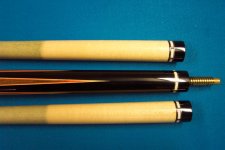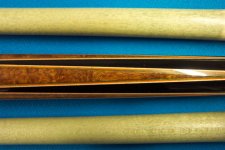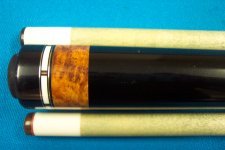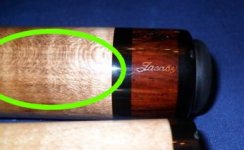I'm sure it's not only me who thinks this, but I've not seen anything mentioned. Have any of you noticed that shaft wood isn't what it used to be? The good stuff to me was darker in color, and would have little marks in it from time to time. Now-a-days you get bright white, very clean looking, yet very young looking wood IMO. What happened to the good shaft wood, and where can a simple player like me get his hands on some? The Duke cue I just picked up has some better looking wood in the shaft, but not exactly what I'm speaking of. I'm going to try it tonight hopefully and hope it plays like I believe it should! I haven't seen any of the good shaft wood for sale here, to me it all looks too young? Thanks for any info that helps me, Jeff <----likes dirty looking shaft wood!
You are using an out of date browser. It may not display this or other websites correctly.
You should upgrade or use an alternative browser.
You should upgrade or use an alternative browser.
shaft wood?
- Thread starter dukeboy1977
- Start date
I'm sure it's not only me who thinks this, but I've not seen anything mentioned. Have any of you noticed that shaft wood isn't what it used to be? The good stuff to me was darker in color, and would have little marks in it from time to time. Now-a-days you get bright white, very clean looking, yet very young looking wood IMO. What happened to the good shaft wood, and where can a simple player like me get his hands on some? The Duke cue I just picked up has some better looking wood in the shaft, but not exactly what I'm speaking of. I'm going to try it tonight hopefully and hope it plays like I believe it should! I haven't seen any of the good shaft wood for sale here, to me it all looks too young? Thanks for any info that helps me, Jeff <----likes dirty looking shaft wood!
That all started with Meucci. He convinced the cue buying public that white whippy shaftwood was the best. Somehow that became the "cream of the crop". Now people don't even think about it. They want the clear white shaftwood and actually believe it's the best! This is also why some people believe that one piece, full spliced cues are the benchmark. What they should strive to make their cues play like. The thing that makes the house cues play or feel "better" is the fact that they don't use that white whippy maple in their shafts. It has nothing to do with the "full splice". I'm afraid that people are like sheep. They listen to other sheep who preach the wrong sermon.
dark woods
I have two Omens and both have darker shafts. I can tell you that they hit stiffer than anything I have tried thus far and still have great feedback. I really like these, the big pin and wood to wood is a hard combo to beat.
I have two Omens and both have darker shafts. I can tell you that they hit stiffer than anything I have tried thus far and still have great feedback. I really like these, the big pin and wood to wood is a hard combo to beat.
Attachments
I have had two shafts made for me recently from Timeless Timber salvaged wood.
Both are very dark by today's standards.
And they are both quite stiff considering their taper (12" pro) and ferrule diameter (12.3 mm).
Dave, are these shafts maple?
Dave, are these shafts maple?
Definitely!
Send a PM to Sheldon (Lebow, cuemaker from Oregon) to see if he has any more blanks.
That all started with Meucci. He convinced the cue buying public that white whippy shaftwood was the best. Somehow that became the "cream of the crop". Now people don't even think about it. They want the clear white shaftwood and actually believe it's the best! This is also why some people believe that one piece, full spliced cues are the benchmark. What they should strive to make their cues play like. The thing that makes the house cues play or feel "better" is the fact that they don't use that white whippy maple in their shafts. It has nothing to do with the "full splice". I'm afraid that people are like sheep. They listen to other sheep who preach the wrong sermon.
I don't prefer the stiffness of house cues. My cues always have a bit of flex, even the break cues.
Here's a couple of pics that I just took of the two TT shafts vs. a typical white shaft.I have had two shafts made for me recently from Timeless Timber salvaged wood.
Both are very dark by today's standards.
And they are both quite stiff considering their taper (12" pro) and ferrule diameter (12.3 mm).
As you can see, the TT shafts are quite dark by comparison.
And all three shafts are clean.


Dark=higher Density?
Is the darker wood more dense?(gpi). Or older? More 'weathered'?
Hopefully more cuebuilders will comment and educate us on this subject.
And while you're at it-it would be great to get cuebuilder opinions on BE or Curly for shafts-good/bad playing characteristics. Depend on light, medium or heavy figureing throughout the shaft? or differences in playability if the figure is mostly at the tip, middle or collar portion of the shaft?
Maybe these are trade secrets. If so, OK.
Is the darker wood more dense?(gpi). Or older? More 'weathered'?
Hopefully more cuebuilders will comment and educate us on this subject.
And while you're at it-it would be great to get cuebuilder opinions on BE or Curly for shafts-good/bad playing characteristics. Depend on light, medium or heavy figureing throughout the shaft? or differences in playability if the figure is mostly at the tip, middle or collar portion of the shaft?
Maybe these are trade secrets. If so, OK.
Too many new cuemakers who think they know how to make cues are using up the supply of wood.
Too many cuemakers who think they know how to make cues buy cr@ppy wood because they have no clue. And they don't care because the buyers don't care.
The wood doesn't have to be dark. The grain has to be straight and preferably, but not necessarily, tight. Also helps if the grain a darkly colored. Maple shafts that have chatoyance also tend to be very stiff with a very sharp hit.
Too many cuemakers who think they know how to make cues buy cr@ppy wood because they have no clue. And they don't care because the buyers don't care.
The wood doesn't have to be dark. The grain has to be straight and preferably, but not necessarily, tight. Also helps if the grain a darkly colored. Maple shafts that have chatoyance also tend to be very stiff with a very sharp hit.
Last edited:
Tom Coker (Coker Custom Cues) has been turning Shafts from 100+ yr. old Bowling Alley Wood (Maple).
They have the color and stiffness properties you are looking for.
He is currently restoring an old Titleist for me and will supply this type of Shaft.
(916) 383-4410
They have the color and stiffness properties you are looking for.
He is currently restoring an old Titleist for me and will supply this type of Shaft.
(916) 383-4410
What the heck is "chatoyance"?
very nice!
Now THIS is what I'm talking about! I remember shafts just a hair darker and a little 'dirtier', but these are very close to what I like! I bet they hit very well sir, great pick up!
Now THIS is what I'm talking about! I remember shafts just a hair darker and a little 'dirtier', but these are very close to what I like! I bet they hit very well sir, great pick up!
They exist.
Last edited:
What the heck is "chatoyance"?
You know those shifting markings you see in between birdseye maple? If you turn your birdseye maple 90 degrees, ie the sides of the maple that don't show the birdseye, you will see these shaded marking that change and shimmer when you angle the maple back and forth.....THAT.
Some shafts will also have a similar chatoyance. Ask any cuemaker who knows his s***t. They[cuemakers] generally don't use the "good stuff"(dark, heavy grained etc etc) shafts because people like the bland clean white stuff. Chatoyance is a word generally used for gems and rocks.
Attachments
Last edited:
my shaft!
The shaft for that 'Duke cue' I just bought has a little section of this mentioned marking about 5 inches from my tip! When I saw it, I knew it must be a nice shaft...I hope it plays nicely anyways!! Those of you who passed up that Mcdermott Duke cue missed out on a nice cheap playing cue, THANK YOU! lol
You know those shifting markings you see in between birdseye maple? If you turn your birdseye maple 90 degrees, ie the sides of the maple that don't show the birdseye, you will see these shaded marking that change and shimmer when you angle the maple back and forth.....THAT.
Some shafts will also have it. Ask any cuemaker who knows his s***t. They generally don't use the "good stuff"(dark, heavy grained etc etc) shafts because people like the bland clean white stuff.
The shaft for that 'Duke cue' I just bought has a little section of this mentioned marking about 5 inches from my tip! When I saw it, I knew it must be a nice shaft...I hope it plays nicely anyways!! Those of you who passed up that Mcdermott Duke cue missed out on a nice cheap playing cue, THANK YOU! lol
The shaft for that 'Duke cue' I just bought has a little section of this mentioned marking about 5 inches from my tip! THANK YOU! lol
Very sharp hit, right!
Older house cues will have them occasionally because 1...they're old, and 2,,,lots of people think it's throw-away wood. The way to spot them from afar is that they're really old, dark, and chalk ridden from use. The newer house cues don't usually have them.
Find a cuemaker and describe the wood. Have him make a shaft for you. chances are, a good cuemaker will have them stacked because, as i said, customers like the clean bland stuff. It looks prettier. Personally, I think the chatoyance looks prettier.
best wood
Hy there,
there are several facts which are important for real good (& stiff shafts):
- the older the wood the closer the age rings the stiffer the shaft!
- maple is not maple. Means there is a big difference between the sort of
trees (I'm not too familiar with this point. I just know it makes a big
difference!!
- it also makes a difference if you chop the tree in winter or in summer.
(as far I remember winter is the preferred time)
- and the last thing is the drying process!
naturally dried wood maintains the "soul" of the wood;
drying methods (like oven f.e.) reduce the wood's quality.
I hope these information are useful to you all
Hy there,
there are several facts which are important for real good (& stiff shafts):
- the older the wood the closer the age rings the stiffer the shaft!
- maple is not maple. Means there is a big difference between the sort of
trees (I'm not too familiar with this point. I just know it makes a big
difference!!
- it also makes a difference if you chop the tree in winter or in summer.
(as far I remember winter is the preferred time)
- and the last thing is the drying process!
naturally dried wood maintains the "soul" of the wood;
drying methods (like oven f.e.) reduce the wood's quality.
I hope these information are useful to you all



